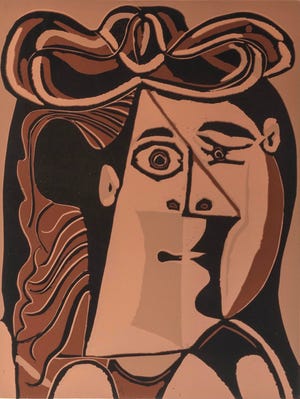Daniel Fulco, Ph.D.
As summer concludes, the museum is preparing for an exciting fall exhibition schedule.
“Picasso on Paper: The Artist as Printmaker, 1923–72” will be at the museum Nov. 11 through March 3.
The first exhibition at the museum devoted to Spanish-born artist Pablo Picasso since 1972, “Picasso on Paper” features 62 etchings, engravings, lithographs and linocuts created by this renowned modern master over a 50-year period.
Although Picasso is best known for his paintings such as “Les Demoiselles d’Avignon (The Young Ladies of Avignon,” 1907) and “Guernica” (1937), he also was a prolific printmaker, producing over 2,400 prints during his career. This exhibition takes us on a journey through Picasso’s innovative modes of creative expression and reveals his pioneering techniques in the medium.
Among the most famous artists ever, Picasso exerted a significant impact on the evolution of modern art internationally. Along with his colleague Georges Braque, Picasso is perhaps best known for his key role in revolutionizing visual art through the development of Cubism in the early 1900s.
As visitors will see in this exhibition, his work (often autobiographical) and artistic technique were constantly evolving. A painter, sculptor, printmaker, ceramist and theater designer, Picasso did not employ a single style. Instead, he enjoyed shifting between and combining abstraction and classicism.
Picasso centered on a range of subjects, in particular the women-muses with whom he had strained, complicated relationships. Over the course of his nearly 80-year career, most of which he spent in France, he also depicted his studios, scenes from literature and classical mythology, bull fights and works inspired by European Old Master paintings and prints.
Over the decades, Picasso worked with many print studios, collaborating closely with their owners and workshop assistants. Among those printers were Roger Lacourière, Fernand Mourlot, Hidalgo Arnéra, and Aldo and Peter Crommelynck, with whom he mastered techniques such as etching, lithography and linocut.
The show begins with etchings and engravings Picasso made at Lacourière’s workshop from 1923 to 1944. This studio greatly assisted the artist with time-consuming tasks, notably preparing plates and pulling proofs, allowing him to focus more on exploring new possibilities of the media.
During this period, Picasso developed his ambitious “Vollard Suite” (1933-39, published by Picasso’s dealer, Ambroise Vollard), which contains more than 100 etchings in the neoclassical style.

Among the remarkable works in this series is “Marie-Thérèse Dreaming of Metamorphoses” (1933), a work that was printed in four states (states are variations of a print, caused by deliberate changes to a plate or other matrix.)
This etching depicts a seated Minotaur (half-man, half-bull), symbolic of the artist’s alter ego, and a bearded man toasting; the three women resemble Picasso’s lover, Marie-Thérèse Walter, for whom he left his first wife, ballet dancer Olga Khokhlova.
Reclining in the foreground, Walter imagines these characters hovering around her. Notice how Picasso employed very gestural, immediate lines that convey emotion and movement. The print’s title might allude to ancient Roman poet Ovid’s Metamorphoses (which interested Picasso greatly) or more generally to transformations over time. Picasso focuses our attention on a retrospective theme; these faces and figures appear to emerge from the shadows and almost haunt Walter.
Picasso also maintained a life-long fascination with works by European Old Masters, including Northern Renaissance painter Lucas Cranach the Elder. A biblical subject from the Old Testament, “David and Bathsheba” (1949, lithograph made in 13 states with Mourlot) is based upon the German artist’s original oil painting.
Here, in the 10th state, Picasso reinterpreted this story, the erotic theme of which no doubt appealed to him. Contrasting areas of light and dark to great dramatic effect, the artist showed King David (possibly representing Picasso himself) eagerly gazing from above at Bathsheba, who wears a richly textured, elaborate floral dress reminiscent of one worn by Françoise Gilot, Picasso’s partner at the time.
Another major focus of this exhibition is Picasso’s use of linocut. In conjunction with Arnéra, Picasso worked extensively in this medium from the 1950s to the 1960s because its process was faster than making etchings and lithographs.

To create works like “Head of a Woman with a Hat” (1962), the artist cut a design into a linoleum block with a sharp knife, V-shaped chisel or gouge, with the raised areas representing a mirror image of the parts to show printed.
Picasso then inked the linoleum with a roller (called a brayer) and finally impressed it onto paper, the results of which are represented in the show through five prints in black and white and copper-colored ink. These prints are especially intriguing because we can progressively observe how Picasso manipulated light, color and form in different states to alter our perception of the same subject.
Drawn from the collection of Timothy Collins, this exhibition is organized by Landau Traveling Exhibitions, Los Angeles, Calif.
Daniel Fulco, Ph.D., is the Agnita M. Stine Schreiber Curator at the Washington County Museum of Fine Arts. The museum is open Tuesday through Friday, 10 a.m. to 5 p.m., Saturday, 10 a.m. to 4 p.m. and Sunday, 1 to 5 p.m., closed Mondays and is closed Thanksgiving, the day after Thanksgiving, Christmas, New Year’s Eve and New Year’s Day. Go to www.wcmfa.org or call 301-739-5727. Follow WCMFA on Facebook, Instagram, YouTube and LinkedIn.






